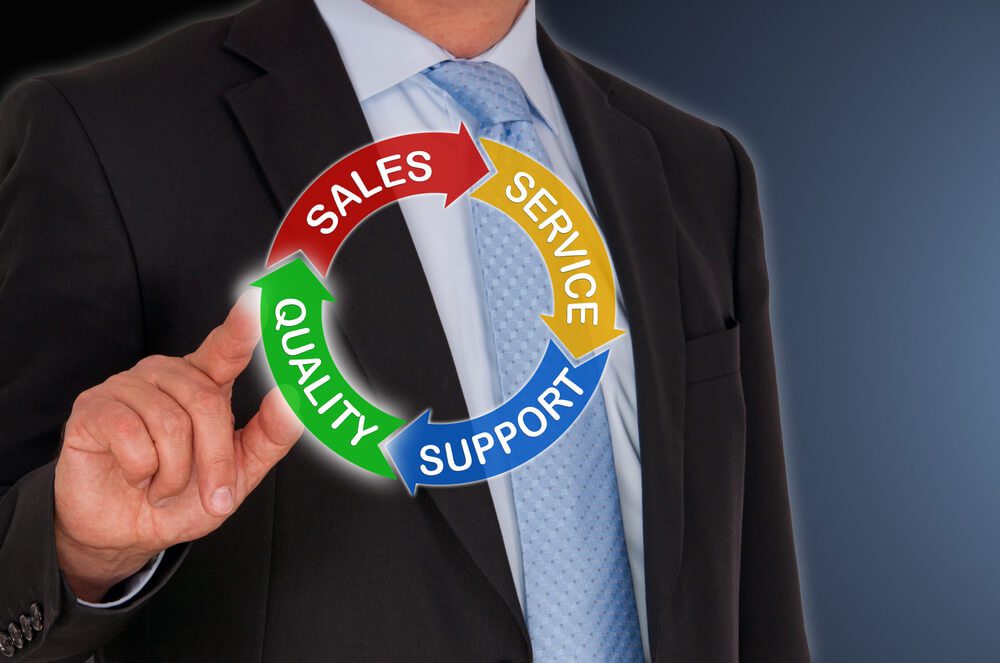
From Outreach to Close: Streamlining the Sales Cycle
- Traditional sales cycle
- Digital tools and automation
- Personalization
- Friction points in the sales process
Understanding the Modern Sales Cycle
 In any business, understanding the sales cycle is crucial for success. However, the rise of digital tools, ever-changing consumer behaviors, and an increasingly competitive marketplace have made the cycle more complex. To thrive, a streamlined approach is indispensable. In particular, it ensures that potential deals do not stagnate and lead to missed opportunities. Traditionally, the sales cycle consists of five straightforward stages:
In any business, understanding the sales cycle is crucial for success. However, the rise of digital tools, ever-changing consumer behaviors, and an increasingly competitive marketplace have made the cycle more complex. To thrive, a streamlined approach is indispensable. In particular, it ensures that potential deals do not stagnate and lead to missed opportunities. Traditionally, the sales cycle consists of five straightforward stages:1. Lead generation: This is the initial stage where you attract potential customers to your business. In the past, this often involved cold calling or mass mailing. In today’s landscape, digital avenues to boost lead generation are numerous and essential.
2. Qualification: At this stage you determine whether the leads fit your product or service. This usually involves some engagement, such as initial emails or calls.
3. Proposal: After determining a qualified lead, you craft a sales proposal and send it for review.
4. Negotiation: If the lead responds positively to the proposal, negotiations on pricing, delivery, and other terms ensue.
5. Close: Finally, you close the deal and sign contracts, and the sales process concludes with the transfer of goods or the initiation of services.
These steps worked well enough in a pre-digital era. However, the game has changed. With the advent of digital tools and intricate analytics, companies now engage prospects in a more personalized way. Examples of these tools include customer relationship management (CRM) systems and artificial intelligence (AI). In addition, a crowded marketplace and the rise of informed consumers mean the traditional process is obsolete. It is too slow or generalized, causing leads to lose interest and switch to competitors. That is where streamlining comes into play. If your sales cycle is elongated or convoluted, you will likely lose potential sales. Quickly moving leads through your sales funnel is critical to closing deals in this high-speed, highly competitive digital world. As a result, the old adage, “Time kills all deals,” has never been more accurate. You cannot afford to let opportunities sit idle. Streamlining ensures you are agile enough to move with the pace of the consumer and the industry, making it a key component in mastering the modern sales cycle.Incorporating Digital Tools and Automation
 Digital tools are essential in modern sales. It is not just about doing old tasks in new ways but about transforming the sales cycle entirely. In particular, three technologies are leading this revolution: CRM platforms, AI-powered chatbots, and automated email campaigns. These tools make communication smooth, track interactions meticulously, and enable rapid, personalized responses.
Digital tools are essential in modern sales. It is not just about doing old tasks in new ways but about transforming the sales cycle entirely. In particular, three technologies are leading this revolution: CRM platforms, AI-powered chatbots, and automated email campaigns. These tools make communication smooth, track interactions meticulously, and enable rapid, personalized responses.1. CRM Platforms: The Modern Sales HQ
CRM platforms have evolved from mere databases to full-fledged command centers for sales operations. Here is how they add value:- Organized data: Imagine having every piece of information about a lead or a client at your fingertips. CRMs do just that, keeping everything from names and emails to meeting notes in one centralized hub.
- Automated administration: Scheduling follow-up emails, setting reminders, and even data entry can be time-consuming. CRMs handle these tedious tasks, leaving you more time to focus on the sale.
- Analytics and forecasting: How well are you doing, and what should you do next? CRMs analyze data to provide insights into sales trends, offering crucial guidance for decision-making.
- Team collaboration: A CRM is a shared workspace where team members from various departments can log in, update information, and keep everyone else in the loop.
2. AI-Powered Chatbots: The Future Is Conversational
AI has left the realm of science fiction. It is now seeing widespread use in various industries. In sales, AI-powered chatbots can pull off remarkable feats:- Immediate customer service: These chatbots handle routine queries almost instantaneously, at any time of day or night.
- Pre-screening leads: Chatbots can ask a series of questions to help qualify leads, saving you valuable time and effort.
- Always available: Their round-the-clock availability means you are never closed for business, opening the door to international clients in different time zones.
- Smart data collection: Every interaction helps these bots learn and collect data, adding a powerful weapon to your marketing arsenal.
3. Automated Email Campaigns: The Power of “Set and Forget”
Email is not going anywhere, especially when it is this effective. Automated email campaigns can do the following:- Keeping leads warm: A series of well-timed emails nurtures a lead from “maybe” to “yes” while you focus on other tasks.
- Personalized messaging: From the prospect’s name to the details of their last interaction with your company, personalization makes each email feel as if it comes from a friend, not a corporation.
- Timely follow-ups: The system automatically sends follow-up emails based on various triggers, such as a completed purchase or an abandoned cart.
- Data-driven decisions: Automated emails also provide key metrics, such as open and click-through rates, which can be analyzed to refine strategies.
The Power of Personalization and Reducing Friction Points
 The digital landscape has made one-size-fits-all approaches obsolete. Businesses need a personalized approach to compete. This involves strategies that focus on individual needs and pain points. Let us go into more detail below:
The digital landscape has made one-size-fits-all approaches obsolete. Businesses need a personalized approach to compete. This involves strategies that focus on individual needs and pain points. Let us go into more detail below:1. Tailored Outreach: More Than Just a “Hi”
- Hyper-personalized emails: Emails can be tailored to speak directly to a prospect’s needs and concerns using data-driven insights. This increases engagement and click-through rates.
- Customized offers: Special promotions or bundled packages can be tailored to suit the interests of specific customer segments.
- Behavior-based targeting: Analyzing user behavior on your website or past purchase history can inform more relevant and timely outreach.
2. Dynamic Demonstrations: Show, Don’t Just Tell
- Interactive demos: Real-time, interactive product or service demonstrations can be adapted on the fly to focus on aspects that interest the prospective client.
- Virtual reality experiences: For more complex products or services, a fully immersive VR experience can offer a far more compelling case than a simple slideshow.
3. Active Listening: The Forgotten Art
- Open-ended questions: Encouraging prospects to share more about their needs and concerns provides invaluable insights.
- Feedback loops: Regular check-ins or post-interaction surveys provide ongoing information, which can be acted upon to continually refine the sales process.
4. Identifying and Reducing Friction Points
Even with all these personalization strategies, sales can still stall when they hit various friction points:- Long contract negotiations: The key is to keep terms straightforward and anticipate potential sticking points.
- Unclear value proposition: If clients do not see the value, they do not buy. Ensure your unique value proposition is clear, concise, and compelling.
- Lack of trust: Building rapport and trust goes a long way toward smoothing out the sales process. Social proof, such as testimonials or case studies, can help validate your offerings.
Common Friction Points in the Sales Process
 The sales landscape is in constant flux. This ebb and flow is compounded by evolving digital marketing trends, making it harder to keep up. When friction points are neglected, they can throw a wrench in even the most well-planned sales process. Protect your sales process by identifying and using strategies to overcome these bottlenecks. Doing so can differentiate between a closed deal and a lost opportunity. Let us detail some of these common friction points and how to resolve them:
The sales landscape is in constant flux. This ebb and flow is compounded by evolving digital marketing trends, making it harder to keep up. When friction points are neglected, they can throw a wrench in even the most well-planned sales process. Protect your sales process by identifying and using strategies to overcome these bottlenecks. Doing so can differentiate between a closed deal and a lost opportunity. Let us detail some of these common friction points and how to resolve them:1. Lengthy Contract Negotiations: Simplify to Amplify
- Standardized agreements: Wherever possible, streamline the contract to include standardized clauses that are straightforward and less open to interpretation.
- Preemptive moves: Expect common points of contention and address them proactively in your initial contract draft, reducing back-and-forths.
2. Ambiguous Pricing: Clear Is Kind
- Transparent pricing models: Murky pricing is a huge turn-off. Clearly state what is included in each pricing tier and what would constitute an additional charge.
- Customizable packages: Offer options for customization without hidden fees so that prospects can tailor the offering to their needs and budget.
3. Unclear Value Proposition: Speak Their Language
- Highlight ROI: Focus on your product or service’s return on investment, translating features into benefits.
- Solution-oriented approach: Identify specific problems the prospect is facing and demonstrate how your offering solves them.
4. Information Overload: Less Can Be More
- Curated content: It is tempting to provide all possible information, but this can overwhelm potential customers. Offer concise, targeted information addressing their specific concerns.
- Staged engagement: Break down the sales process into digestible stages, offering more detailed information as prospects move further down the funnel.
5. A Lack of Personal Connection: Build Trust, Build Sales
- Social proof: Use testimonials, case studies, and industry awards to establish credibility.
- Personal engagement: Whether a handwritten note or a personalized video message, a personal touch can often be the tiebreaker when prospects weigh options.
Summing Up
Going through the complexities of the modern sales cycle can be daunting, but it is crucial for staying competitive. To master this landscape and drive revenue, consider hiring a fractional CRO from Digital Authority Partners. Ready to elevate your sales game? Contact us today to get started.Want To Meet Our Expert Team?
Book a meeting directly here



